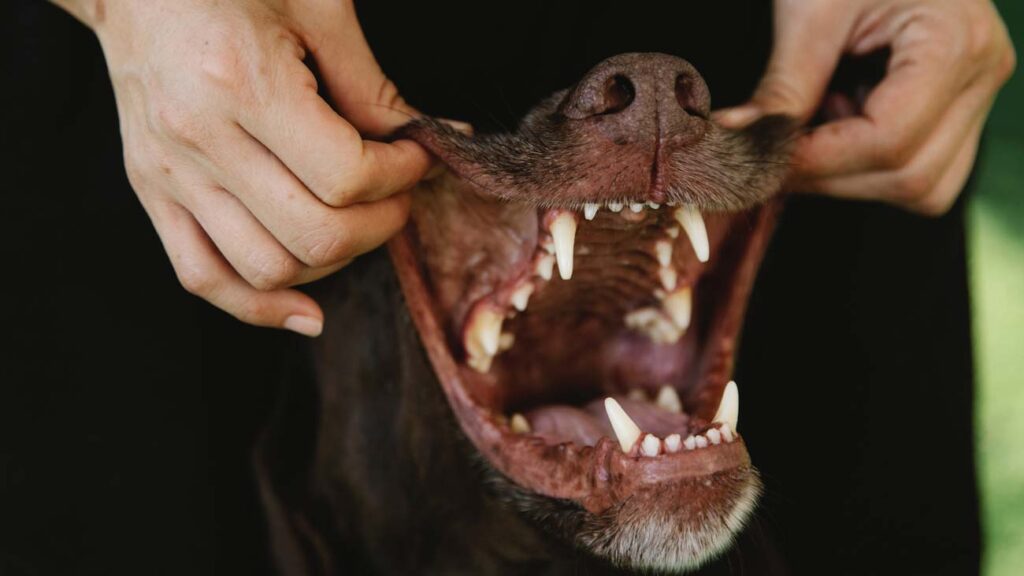
A dog's teeth: What do they need?
As we already know, dogs are facultative or opportunistic carnivores, which means that they feed mainly on meat, but they can also feed on other things, such as vegetables and fruits.
The teeth have different shapes and different functionality, that is why the teeth of a herbivorous animal are very different from those of a carnivore such as a dog.
In dogs, there are several types of teeth according to their position and function:
- Incisors are located in the front of the mouth and implanted in the premaxillary bone and in the jaw. They are responsible for cutting and tearing.
- The canines or fangs are found a little further back, they are two pairs and the longest teeth. They are adapted for puncturing and tearing.
- The premolars constitute, together with the molars, the dental arch, and their function is to tear and cut the flesh, the same as the incisors.
- The molars are the largest, are located on the sides and only appear in the permanent dentition. Their function is to crush and grind.
What are a dog's teeth like?
In puppies: molars appear from about 5 months of age. They have 28 milk teeth, of which 6 are incisors, there are 2 fangs and 6 premolars (upper and lower).
In adults: they have 42 teeth: 6 incisors, 2 fangs, 8 premolars (top and bottom), 4 molars in the upper jaw and 6 in the lower jaw.
From the anatomy of their teeth, it is logical to understand that the main food that dogs should eat would be meat, since their dentition is prepared to tear and cut.
How does the food we feed influence it?
As we mentioned, dogs can eat other foods in addition to meat. Vegetables and fruits are within this allowed and healthy diet, although we must ensure that we do not exceed 5% of the intake of these foods extra, outside the diet (if the natural diet already incorporates vegetables and fruit, we can still give up to 5% more). A complete and balanced natural diet for dogs will always contain these foods, together with meat, offal, proteins, vitamins and essential fatty acids.
Cooked dog food is characterized, among other things, by not leaving food residues in their teeth, in addition to maintaining a visible hygiene and neutralized odor, since it also prevents gastrointestinal diseases that can lead to halitosis.
What happens when we give them processed foods such as animal feed, commercial snacks or cans?
Processed foods contain a high percentage of chemicals, processed foods, colorings and flavorings that result in poor and bad nutrition for our dogs.
In addition, these foods are characterized by leaving a large amount of stains on the teeth, which would lead to the appearance of tartar. Apart from this, a poor diet can lead to gum infection, serious diseases such as canine periodontal disease and even loss of teeth.
When we opt for a natural diet and provide unprocessed food, we help their immune system to be strong and healthy to fight infectious processes and at the same time their oral hygiene is favored, since we are not providing chemicals to their food and in conclusion, we reduce tartar and bad odor.
Surely we have heard a few times that they really need the feed to drag the dirt from the teeth, but the truth is that it is the feed itself that is generating this dirt.
Benefits of meaty bone and recreational bone
Fleshy bones are an excellent source of vitamins, minerals, water, protein, fatty acids, essential amino acids, antioxidants and energy. In addition, they are a rich source of calcium and phosphorus, two essential minerals in the diet of dogs.
Recreational bones: they provide proteins of high biological value. They are rich in collagen, calcium, phosphorus, amino acids and fatty acids. They are ideal for calming anxiety. In fact, it has been shown that while gnawing on these bones, there is a release of endorphins. These bones should be larger than their head and wider than their muzzle, to prevent them from swallowing them and choking or causing some kind of perforation.
In either case, they should never be provided without a human present to supervise the process.
What kind of bones can we give?
MEATY BONES
- Turkey necks
- Whole lamb or veal necks
- Chicken or turkey carcasses
- Lamb or veal skirt
- Beef scapula
RECREATIONAL BONES
- Cow femur
- Knee of cow
- Pig femur
These bones, together with the natural teethers, are perfect to complement a healthy and balanced diet, favoring oral and dental health by chewing in the most natural and healthy way possible.
Do you like what we do at Bon Appetreat?
Experience tells us that it’s best to see for yourself.

Phone/Text
Mon To Sun:
10:00 AM To 6:00 PM
Email Us:
info@Bon-Appetreat.com
2520 Coral Way, Ste 2
Miami, Fl 33145
For packages only
Join our community and save on wellness.
We’ll help you find the food that is right for your pet.
Our Products
Support
Get In Touch
Copyright © 2023 Bon Appetreat. All rights reserved – Privacy Policy – Returns Policy